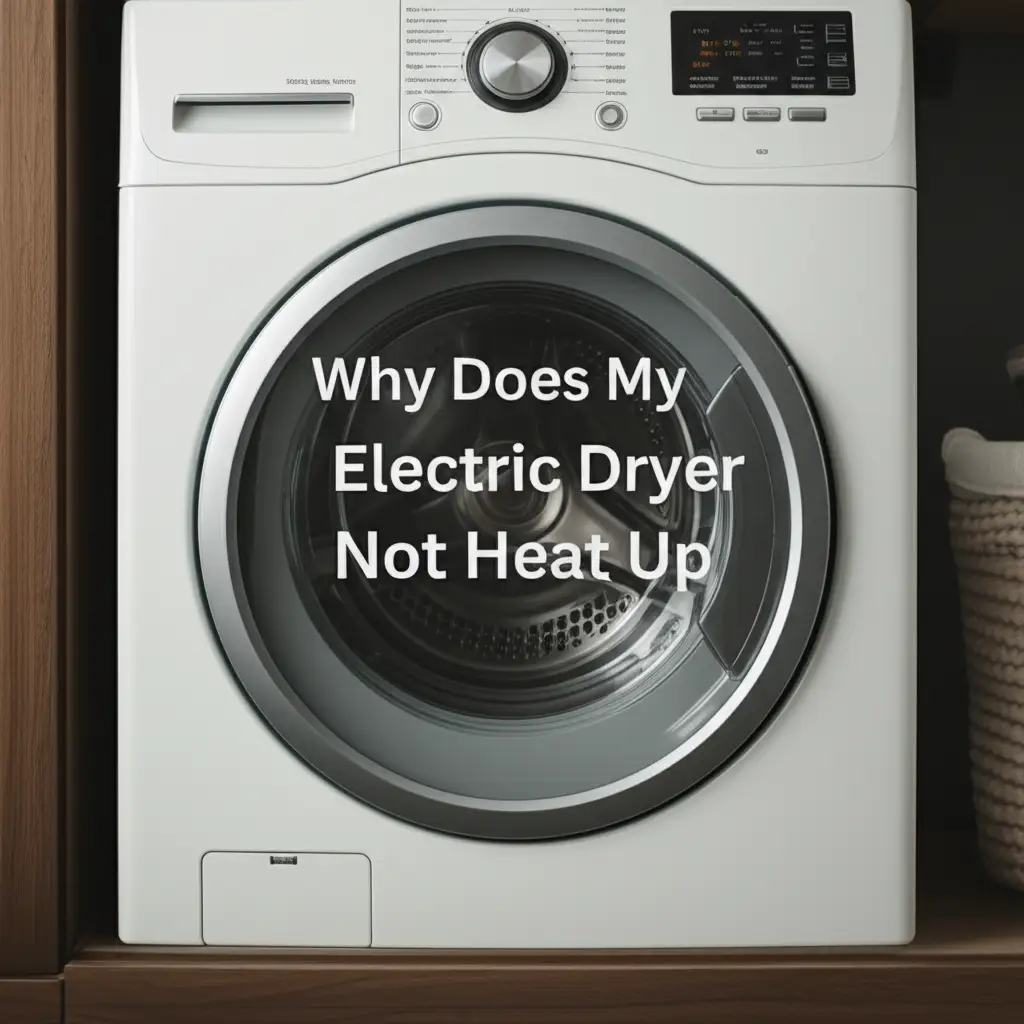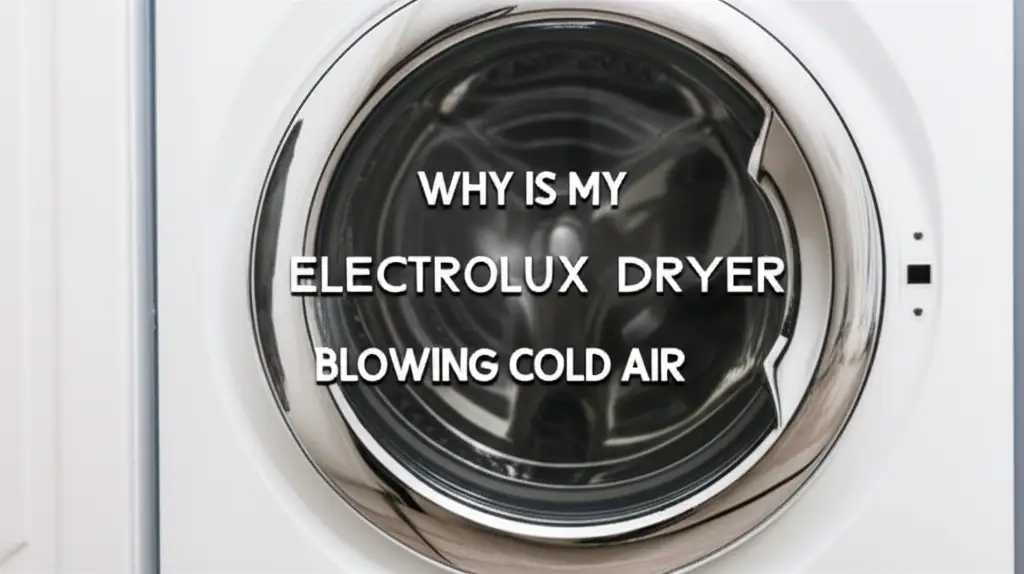· Todd Martin · Appliance Repair · 20 min read
Why Does My Electric Dryer Not Heat Up

Electric Dryer Not Heating? Common Reasons Why
There are few things as frustrating as pulling laundry from your washing machine only to find your electric dryer does not heat up. A non-heating dryer leaves you with damp clothes and a big problem. I know the feeling well; it throws off your whole laundry routine. It can feel daunting to diagnose why your electric dryer isn’t producing heat. Often, the cause is a simple fix you can do yourself.
This guide will help you understand the common reasons your electric dryer may not be heating. We will explore everything from power issues to specific component failures. I will provide clear steps to troubleshoot and fix these problems. Our goal is to get your dryer working again. Let’s dive in and solve this no-heat mystery together.
Takeaway
- Check the Power First: Ensure the dryer has power and the circuit breaker is not tripped. Electric dryers need specific voltage.
- Inspect Airflow: Clean the lint filter and check the dryer vent for clogs. Poor airflow causes dryers to overheat and stop heating.
- Test Key Components: Diagnose the heating element, thermal fuse, and thermostats. These parts are common culprits for no heat.
- Consider Professional Help: If DIY troubleshooting fails, a qualified technician can identify complex issues safely.
Why Does My Electric Dryer Not Heat Up?
Your electric dryer does not heat up primarily due to issues with its electrical supply, a clogged ventilation system, or a failure in one of its heating or safety components. These parts include the heating element, thermal fuse, cycling thermostat, or high-limit thermostat.
Understanding How Your Electric Dryer Produces Heat
An electric dryer uses electricity to generate heat. This heat then dries your clothes. Air gets heated by a special part called the heating element. A fan blows this hot air through the drum. The hot, moist air then leaves the dryer through a vent.
Many parts work together to make this process happen. If one part fails, your dryer might not heat up. Understanding these parts helps you find the problem. We will look at what each key component does.
The Heating Element
The heating element is crucial for drying clothes. It is a coil of wire that gets very hot when electricity passes through it. This heat warms the air entering the dryer drum. If this element breaks, the dryer will run but stay cold. A broken heating element is a common reason for a dryer with no heat.
You can often see the heating element inside a metal housing. It is usually at the back of the dryer drum. Testing it requires a multimeter. A working element will show a specific electrical resistance.
Thermostats and Their Purpose
Electric dryers have several thermostats. These parts control the temperature and ensure safety. They prevent the dryer from getting too hot. Each thermostat has a specific job.
- Cycling Thermostat: This thermostat turns the heating element on and off. It maintains the chosen drying temperature. If it fails, the dryer might not heat at all.
- High-Limit Thermostat: This is a safety device. It trips if the dryer gets too hot. This prevents fires or damage. It usually needs to be replaced after tripping.
- Thermal Cut-Off Fuse (Thermal Fuse): This is another safety device. It’s a one-time fuse. If the dryer overheats severely, this fuse blows. Once blown, it permanently breaks the circuit. This stops the dryer from heating completely. You must replace a blown thermal fuse.
Checking Your Dryer’s Power Supply and Circuit Breaker
The first step in fixing a non-heating electric dryer is to check its power source. Electric dryers require a specific 240-volt power supply. They connect to two separate circuit breakers in your home’s electrical panel. If one breaker trips, the dryer might still tumble but will not heat. This is a common issue many people overlook.
My own dryer once stopped heating, but it still tumbled. I thought it was a major problem. It turned out one of the dryer’s circuit breakers had tripped. It was a simple fix.
Verifying the Circuit Breaker
Go to your home’s main electrical panel. Look for the circuit breakers labeled for your dryer. They are usually two adjacent breakers connected by a bar. These are often 30-amp breakers.
If one or both breakers are in the “tripped” position (often halfway between “on” and “off”), flip them completely to “off” first. Then, push them firmly to the “on” position. If a breaker immediately trips again, there is a serious electrical problem. You should not attempt further repairs yourself. This suggests a short circuit or a faulty component drawing too much power. This might be a reason why your electric dryer keeps tripping the breaker.
Testing the Power Outlet
Even if the breakers seem fine, you can check the dryer outlet. You need a voltage tester or a multimeter. Set the tester to measure 240 volts AC. Carefully insert the probes into the outlet slots.
You should get a reading of around 240 volts. If you get 120 volts, or no voltage, there is a wiring problem. This indicates an issue with the outlet or the wiring behind it. Do not use the dryer if the outlet wiring is faulty. This requires a qualified electrician. Power issues are fundamental. You cannot troubleshoot components without proper power.
The Role of the Thermal Fuse and Thermostats
When your electric dryer does not heat up, the thermal fuse and various thermostats are primary suspects. These components are critical for both heating regulation and safety. They monitor the dryer’s temperature. If the temperature gets too high, they cut off power to the heating element. This prevents overheating and potential fires. Understanding their function helps pinpoint the problem.
Locating and Testing the Thermal Fuse
The thermal fuse is a small, non-resettable safety device. It is usually located on the exhaust duct near the blower housing. Its purpose is to blow if the dryer overheats. Once it blows, it creates an open circuit. This stops power from reaching the heating element. The dryer might still tumble, but it will not produce heat.
To test the thermal fuse, you need a multimeter. Disconnect the dryer from power first. Remove the fuse and set your multimeter to continuity mode. Touch the probes to the fuse’s terminals. A good fuse will show continuity (a beep or a zero reading). A blown fuse will show no continuity. If it has no continuity, you must replace it. You cannot repair a blown thermal fuse. If you want to understand why electric dryers need to be vented, it’s often to prevent such overheating.
Examining the Cycling Thermostat
The cycling thermostat controls the temperature inside the dryer drum. It turns the heating element on and off to maintain the selected heat setting. If this thermostat fails, it can either stay open (no heat) or stay closed (overheating). It is typically located on the blower housing or heating element housing.
To test the cycling thermostat, again, use a multimeter set to continuity. Disconnect the dryer and remove the wires from the thermostat. A good cycling thermostat should show continuity at room temperature. If it does not show continuity, it is faulty and needs replacement.
Investigating the High-Limit Thermostat
The high-limit thermostat is another safety feature. It is usually located close to the heating element. Its job is to shut off the heating element if the dryer reaches an unsafe temperature. This prevents damage to the dryer and reduces fire risk. Unlike the thermal fuse, some high-limit thermostats can reset themselves. However, if it frequently trips, it indicates another problem like poor airflow.
Test this thermostat with a multimeter for continuity, similar to the thermal fuse. At room temperature, it should show continuity. If it shows no continuity, it has failed and needs replacing. Remember that if this thermostat failed, there might be an underlying issue. Often, excessive lint buildup or a clogged vent system causes such overheating.
Troubleshooting a Faulty Heating Element
The heating element is the heart of your electric dryer’s heating system. If your electric dryer does not heat up, a broken heating element is a very common cause. It’s designed to generate intense heat. Over time, the coils inside can break or burn out. This can happen due to continuous use or power surges. When the element fails, electricity cannot flow through it to create heat. The dryer will still run, but the air will remain cold.
I have replaced several heating elements myself. It is a manageable DIY repair for many people. It does require some tools and caution.
Accessing the Heating Element
First, unplug the dryer from the wall outlet. This is a crucial safety step. The heating element is usually located in a housing at the rear of the dryer. You may need to remove the back panel of the dryer to access it. Sometimes, you access it from the front or side. Consult your dryer’s service manual for exact instructions. Each dryer model can be slightly different.
Once you find the heating element assembly, you will see the element itself. It is a coiled wire inside a metal chamber. Look for any visible breaks or burnt spots on the coils. Often, a broken element is visibly damaged.
Testing the Heating Element for Continuity
You will need a multimeter to accurately test the heating element. Set the multimeter to the ohms or continuity setting. Disconnect the wires from the heating element’s terminals. Touch one probe to each terminal of the heating element.
A good heating element will show a resistance reading. The specific resistance varies by model, but it is typically between 10 and 20 ohms. If your multimeter shows “OL” (over limit) or “open circuit,” the element has a break. This means no current can flow through it. An open circuit indicates the element is faulty. You will need to replace it. A good electrical dryer repair involves checking this first.
Replacing a Damaged Heating Element
If your tests confirm the heating element is faulty, you must replace it. Heating elements are specific to dryer models. Ensure you purchase the correct replacement part for your electric dryer. Online appliance parts retailers often list parts by model number.
Installation involves reversing the removal steps. Carefully disconnect the old element from its housing. Install the new element, making sure all connections are secure. Reattach any wires and reassemble the dryer panels. Replacing the heating element is a cost-effective solution. This often resolves the “electric dryer not heating” issue. For more specific brand troubleshooting, you can look into reasons why your GE dryer runs but has no heat.
Diagnosing a Clogged Vent or Lint Filter
A common and often overlooked reason why your electric dryer does not heat up or dry clothes effectively is poor airflow. This issue typically stems from a clogged lint filter or a blocked dryer vent. Airflow is crucial for efficient drying. The dryer needs to expel moist, hot air. If this air cannot escape, the dryer becomes less efficient. It can also cause safety components to trip. The dryer might run for a very long time, or it might not heat at all.
I always recommend checking these simple things first. They are easy to fix and prevent bigger problems. It’s often the answer to why your electric dryer takes so long to dry.
The Importance of a Clean Lint Filter
Your dryer’s lint filter traps lint from your clothes. This is its primary function. If you do not clean it after every load, lint builds up. A thick layer of lint severely restricts airflow. When airflow is restricted, the dryer’s internal temperature rises. The safety thermostats (like the thermal fuse or high-limit thermostat) detect this. They will then cut off power to the heating element. This prevents the dryer from overheating.
Always clean the lint filter before starting a new load. Just pull it out and wipe off the lint. You can also rinse it with water and mild detergent once a month. This removes fabric softener residue. A clean lint filter is the first defense against poor airflow. For more comprehensive cleaning, you can learn how to clean your dryer properly.
Checking and Clearing the Dryer Vent
Beyond the lint filter, the entire dryer vent system can become clogged. This includes the flexible duct behind the dryer and the rigid ductwork inside your walls. Lint, pet hair, and even small articles of clothing can accumulate in these vents. A severely clogged vent dramatically reduces airflow. This leads to the same problem: the dryer overheats, and the heating element shuts off.
Steps to check your dryer vent:
- Unplug the dryer: Safety first. Disconnect it from power.
- Disconnect the vent hose: Pull the dryer away from the wall. Detach the flexible hose connecting the dryer to the wall vent.
- Inspect the hose: Look inside for lint buildup. Use a vacuum cleaner attachment to clear it out.
- Check the wall vent: Look into the wall opening. If you can, use a long brush or snake tool. Remove any lint you find.
- Inspect the exterior vent hood: Go outside and check the dryer vent cap. These often get clogged with lint. Remove the cap if necessary and clean thoroughly. Ensure the flapper opens freely. Electric dryers need to be vented outside. Understanding why an electric dryer needs to be vented emphasizes this safety aspect.
Clearing a clogged vent can instantly restore your dryer’s heating function. This also improves efficiency and reduces fire risk. I have seen many cases where this simple step fixes the problem.
Examining the Motor and Blower Wheel
While the heating element creates the heat, the motor and blower wheel are essential for distributing it. They move air through the dryer drum and out the vent. If the motor is not running, or if the blower wheel is obstructed, airflow becomes an issue. Restricted airflow can cause the heating element to shut off due to overheating. It can also make the dryer run, but with no heat. This might be why your Whirlpool dryer runs but no heat.
Inspecting the Blower Wheel
The blower wheel, also called a fan, is usually located behind a front or back panel. It pulls air into the dryer and pushes it out through the exhaust vent. Over time, lint or small items can get stuck in the blower wheel. This prevents it from spinning freely. A damaged or obstructed blower wheel will significantly reduce airflow. This leads to overheating and no heat.
Steps to inspect:
- Unplug the dryer.
- Access the blower wheel: This often involves removing the front, back, or side panel. Refer to your dryer’s manual for specific access points.
- Check for obstructions: Look for lint, socks, or foreign objects. Carefully remove any blockages.
- Inspect for damage: Check if the wheel itself is broken or cracked. A damaged wheel needs replacement.
If the blower wheel is spinning, but airflow still seems weak after cleaning the vent, the wheel itself might be loose on its motor shaft. This reduces its effectiveness.
Checking the Drive Motor
The drive motor powers both the drum rotation and the blower wheel. If the motor is working, the drum will tumble. However, sometimes the motor can run weakly or have issues that affect the blower function. A common issue is a capacitor on the motor failing. This can make the motor run, but without enough power to effectively turn the blower wheel.
If the dryer hums but the drum does not turn, or if the airflow is very weak, the motor could be failing. Testing the motor requires advanced knowledge and tools. It’s usually best left to a professional. If the motor fails, you will likely need to replace the entire motor assembly. A failing motor could also be related to why your electric dryer keeps shutting off prematurely.
Issues with the Timer or Control Board
Modern electric dryers rely on electronic control boards or mechanical timers. These components manage the entire drying cycle, including when to turn the heat on and off. If either the timer or the electronic control board fails, the dryer might not receive the command to heat. This can be a frustrating problem. The dryer appears to operate normally, tumbling clothes, but no heat is produced.
I have seen cases where the main board had a tiny burnt spot, rendering the heating function useless. These issues can be trickier to diagnose for a beginner.
Diagnosing a Faulty Timer
Older electric dryers often use a mechanical timer. This timer clicks through the different cycles. It has internal contacts that send power to various components, including the heating element. If the timer’s internal contacts for the heating circuit burn out or fail, the dryer will continue to tumble but won’t heat.
How to check a mechanical timer:
- Listen: Does the timer make a normal clicking sound as it progresses?
- Test continuity: With the dryer unplugged, use a multimeter to test the specific contacts for the heating circuit on the timer. This requires a wiring diagram specific to your model. If there’s no continuity on the heating circuit contacts, the timer is faulty.
- Visual inspection: Sometimes, you can see burnt marks on the timer’s internal contacts.
Replacing a mechanical timer involves disconnecting wires and mounting screws. Ensure you label all wires before disconnecting them to simplify reinstallation.
Troubleshooting the Electronic Control Board
Newer electric dryers use an electronic control board, or PCB (Printed Circuit Board). This board is the “brain” of the dryer. It processes signals from sensors and sends commands to all components, including the heating element. A malfunction on this board can prevent the dryer from heating. This happens even if all other components are in good working order.
Signs of a faulty control board:
- No heat, but other functions work: The dryer tumbles, lights work, but no heat.
- Intermittent heating: Heat comes on, then goes off randomly.
- Error codes: Some dryers display specific error codes for board issues.
- Burn marks: Visually inspect the board for burnt components or discolored areas.
Testing an electronic control board is complex. It requires advanced electrical knowledge and specialized diagnostic tools. Unlike simple continuity tests, diagnosing a PCB involves checking voltages and signals. For most homeowners, replacing the board is the only practical solution if it is suspected to be faulty.
Replacement involves unplugging the dryer, accessing the board (often behind the control panel), disconnecting wire harnesses, and installing the new board. Ensure the replacement board is exact for your dryer model. A faulty control board or timer can be an expensive repair. However, it is necessary to restore heat function to your electric dryer.
When to Call a Professional Appliance Repair Technician
While many dryer problems are simple DIY fixes, some issues require professional attention. Knowing when to call a professional can save you time, prevent further damage, and ensure your safety. Attempting complex electrical repairs without proper training is dangerous. It can lead to electric shock or even fire.
I always advise homeowners to trust their instincts. If a repair feels beyond your skill level, it probably is.
Complex Electrical Issues
If your circuit breaker continues to trip after resetting, or if you detect burning smells from your dryer or electrical panel, stop using the dryer immediately. These are serious electrical issues. They often indicate a short circuit, faulty wiring, or a problem within your home’s electrical system. A professional appliance technician or a licensed electrician can safely diagnose and repair these problems. They have the specialized tools and knowledge to handle high-voltage circuits.
If you have already checked the common culprits like the heating element, thermal fuse, and thermostats, and the dryer still has no heat, the problem might be more intricate. This could involve the main control board, the motor, or complex wiring issues. These require in-depth diagnostics.
Safety Concerns
Any time you feel unsafe attempting a repair, it’s best to call a professional. This includes situations where:
- You are not comfortable working with electricity.
- You cannot safely access the dryer components.
- The dryer is making unusual noises or producing smoke.
Appliance repair technicians are trained to work safely with various appliances. They understand the intricacies of electrical systems. They can identify hidden dangers that a homeowner might miss.
Time and Cost Considerations
Consider the value of your time and the cost of parts. If you are struggling to diagnose the problem, a professional can often pinpoint the issue quickly. They carry common replacement parts. This can lead to a faster repair than if you order parts yourself.
Sometimes, the cost of parts plus your time spent troubleshooting equals a significant investment. A technician’s fee might be worth it for the peace of mind. They ensure the repair is done correctly and safely. A professional repair also often comes with a warranty on parts and labor. This adds an extra layer of security for your investment. Don’t hesitate to seek help if your electric dryer continues to not heat up despite your best efforts.
Frequently Asked Questions
Why does my electric dryer run but not get hot?
If your electric dryer runs but does not get hot, the most common reasons include a blown thermal fuse, a faulty heating element, or tripped circuit breakers. Other possibilities are a defective cycling thermostat or a clogged vent system. Always check your home’s circuit panel first.
How do I reset the thermal fuse on my electric dryer?
You cannot reset a thermal fuse on an electric dryer. A thermal fuse is a one-time safety device. Once it blows due to overheating, it must be replaced. After replacing, investigate why it blew. Common causes include a clogged lint filter or a blocked dryer vent.
Can a clogged vent cause my electric dryer not to heat up?
Yes, absolutely. A clogged dryer vent severely restricts airflow. This causes the dryer to overheat. When the dryer overheats, safety components like the thermal fuse or high-limit thermostat shut off the heating element. This prevents fire. Clear the vent and lint filter regularly.
How much does it cost to fix an electric dryer heating element?
The cost to fix an electric dryer heating element varies. A replacement heating element typically costs between $30 and $100 for the part itself. If you hire a professional, labor charges can add another $100 to $200, bringing the total to $130-$300. DIY replacement can save money.
What is the lifespan of an electric dryer heating element?
The lifespan of an electric dryer heating element typically ranges from 5 to 10 years. This depends on usage frequency and maintenance. Regular cleaning of the lint filter and dryer vent can extend its life. Overheating from restricted airflow can significantly shorten its lifespan.
My dryer hums but the drum does not turn or heat. What’s wrong?
If your dryer hums but the drum does not turn and there’s no heat, it likely indicates a problem with the drive motor or a broken drive belt. The drive motor powers both drum rotation and the blower fan, which is crucial for heating. A professional may be needed for motor or belt replacement.
Conclusion
Finding out why your electric dryer does not heat up can be frustrating. However, by systematically troubleshooting, you can often identify and fix the issue. We covered the most common culprits. These include electrical problems, faulty heating elements, and crucial safety components like thermal fuses and thermostats. Remember, a clogged vent or lint filter can also prevent your dryer from heating.
Start with the easiest checks, like the circuit breaker and lint filter. Then, move to more involved diagnostics. If you feel uncomfortable or if the problem persists, do not hesitate to call a professional technician. Your safety is always paramount. With these tips, I hope you can get your electric dryer back to making your clothes warm and dry very soon.





